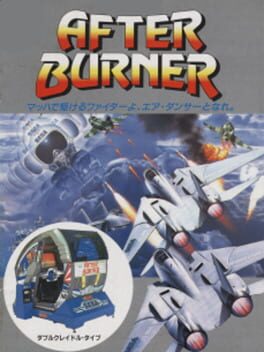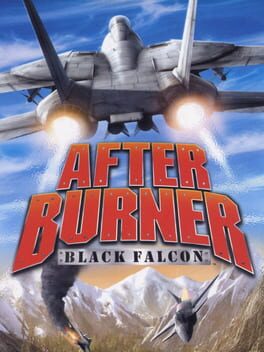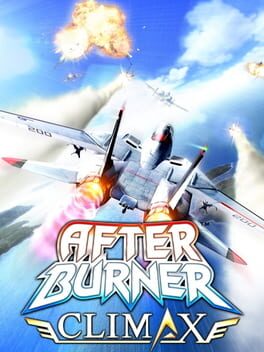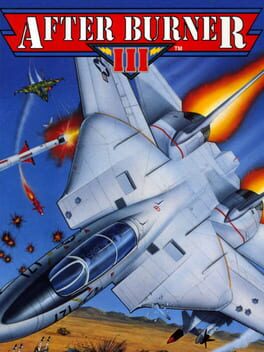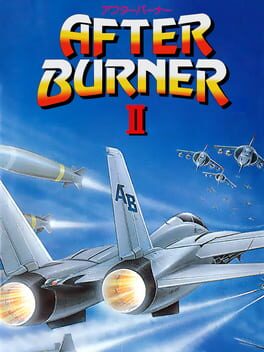

Muster up all the skill, reflexes and guts you've got. Because inside your F-14 Thunder Cat, you're going to need all that - and more. Blast laser-directed, anti-aircraft fire at enemy planes. Dodge heat-seeking missiles with fancy flywork, like dips, turns and barrel rolls. Come head to head with the infamous Flying Fortresses (the toughest of all enemies) and dogfight your way through, to a nanosecond of safety. And if you make it far enough, a fuel tanker will be waiting for you. Dock successfully and you'll replenish valuable energy and ammunition. So get your adrenaline pumping and grab your joystick. Then take to the skies. You're not going to believe what's up there!
Also in series
Reviews View More
Fantastic plane design, and excellent sense of speed. I prefer this to Space Harrier's nonsense, but it still suffers from very shallow and repetitive gameplay. I think one of the issues theses early pseudo 3D games struggled with was how to balance your speed with the introduction of enemies on the screen in such a way that made them reasonable targets for long enough. The solution of having them fly over you from "behind" just doesn't work that well.
For those unaware as to who Yu Suzuki is, he is a game designer who has been in the industry for quite a while now, starting all the way back in 1984. Ever since then, he has since created and developed a wide variety of video games while working with Sega, and have created a lot of classic franchises for the company, such as Outrun, Virtua Fighter, Space Harrier, and most noteworthy, the Shenmue series. Back in the early days though, a good number of the video games that he ended up making primarily involved one gimmick: moving forward. Where most games at the time had the player moving from left to right or stationary at the bottom of the screen moving upwards, a handful of his games from the early days had the player moving straight forward, which was pretty revolutionary for the time, and looking back at now, are still very impressive, even if it didn’t quite spell out the actual quality of the game. One such instance would be with the start of one of the plenty of franchises he has created, After Burner.
I myself have never really played any of Yu Suzuki’s games before playing this one. I had known about them for a while, particularly with Shenmue and Virtua Fighter, and I had always wanted to give them a shot, with Space Harrier being one that I had wanted to get to for a long time. But, being the hypocrite that I am, I decided to try out After Burner first, and I’m glad I did, because this game fucking rocks! Well… somewhat. Being what Sega intended to be their first “blockbuster” title, it is very good for what it offers initially, but it isn’t one of those arcade titles that I would suggest you spend a long time with to try to beat it.
The graphics are pretty great, having as much depth and detail as it needs to, the music is also pretty great, although the sound effects for whenever you take out an enemy can get annoying with how much you hear it throughout, the control is pretty solid and works perfectly for this type of game, although doing the aileron rolls in the air do get a little confusing in terms of getting a grip on them, the movement is fast and frantic, so I of course love it so much, and the gameplay is also fast, challenging, and fun… to an extent.
The game is an arcade rail shooter, where you fly through numerous environments in your jet, shooting a barrage of enemy pilots trying to gun you down, switching between regular gunfire and missiles to get the job done, avoiding their fast and frequent attacks, and in some stages, moving through a series of mountains and other obstacles to not die in a horrific explosion. As you have come to expect, it is all pretty simple stuff, but what makes this work so well, again, is the change in perspective and the speed.
At this point, this style was nothing new in terms of what Yu Suzuki has made, with several other games beforehand also involving you driving forward in a fast vehicle, so naturally, why fix what isn’t broken, am I right? The game has you moving forward constantly at a rapid pace, with what feels like a countless barrage of enemies being thrown at you, either coming from behind or in front, shooting at you whenever they can, with you needing to avoid them all while making sure to shoot down as many as you can. I don’t need to tell you that it gets pretty intense pretty quickly, and you need to be quick on your toes or else you will get shot down pretty quickly… and I'm all in for it. I love it when video games give me a rush of excitement, whether it be through specific moments that occur in a game, a constant streak of victory throughout, or just being incredibly fast and hectic, yet extremely satisfying at the same time. With that being said, this type of gameplay is just what I can gel with, where you need to match the skill and speed of the game, and whenever you do succeed (after, you know, dying a million times), it feels incredible. Yeah, it may not be everyone’s cup of tea, but it is simple enough to keep me entertained for quite a bit.
However, the key part of that sentence is “quite a BIT”, which goes into the problems the game has. In terms of the gameplay, that is about all you can expect from it, just a lot of dogfights with planes and the occasional moving through tight corridors. And that’s it. This type of gameplay is dragged on for 18 stages, so if you aren’t immediately captured by what you are presented from the first couple stages, then there is no real point in you trying to keep going afterwards, even if it is on the shorter side. This also couples with the fact that, in the tradition of arcade games, things get hard pretty fast, so it could also come off as frustrating after a while as well. Even for me, while I was hooked for a good bit, also got to the point where it was like “alright, can we move it along already?”
There’s also the minor, yet still present problem of the perspective aspect not being the best. Given the angle at which things are shot at you, as well as how fast the game is, it is easy to get killed pretty quickly, even in situations where you feel like you couldn’t avoid it, especially when it comes to home console ports of the game. Nevertheless though, I still had a lot of fun with the game, even if it is one that I could only go back to and play for a couple of stages and nothing more from there.
Overall, despite not having too much to offer in terms of gameplay and level design, it is still a very fun arcade classic from Sega’s library that I would definitely recommend, but only for short bursts to get the most enjoyment out of it. And hey, maybe now that I took a look at this game, I can actually get to playing Space Harrier… you know, whenever I feel like it in a month or two.
Game #218
I myself have never really played any of Yu Suzuki’s games before playing this one. I had known about them for a while, particularly with Shenmue and Virtua Fighter, and I had always wanted to give them a shot, with Space Harrier being one that I had wanted to get to for a long time. But, being the hypocrite that I am, I decided to try out After Burner first, and I’m glad I did, because this game fucking rocks! Well… somewhat. Being what Sega intended to be their first “blockbuster” title, it is very good for what it offers initially, but it isn’t one of those arcade titles that I would suggest you spend a long time with to try to beat it.
The graphics are pretty great, having as much depth and detail as it needs to, the music is also pretty great, although the sound effects for whenever you take out an enemy can get annoying with how much you hear it throughout, the control is pretty solid and works perfectly for this type of game, although doing the aileron rolls in the air do get a little confusing in terms of getting a grip on them, the movement is fast and frantic, so I of course love it so much, and the gameplay is also fast, challenging, and fun… to an extent.
The game is an arcade rail shooter, where you fly through numerous environments in your jet, shooting a barrage of enemy pilots trying to gun you down, switching between regular gunfire and missiles to get the job done, avoiding their fast and frequent attacks, and in some stages, moving through a series of mountains and other obstacles to not die in a horrific explosion. As you have come to expect, it is all pretty simple stuff, but what makes this work so well, again, is the change in perspective and the speed.
At this point, this style was nothing new in terms of what Yu Suzuki has made, with several other games beforehand also involving you driving forward in a fast vehicle, so naturally, why fix what isn’t broken, am I right? The game has you moving forward constantly at a rapid pace, with what feels like a countless barrage of enemies being thrown at you, either coming from behind or in front, shooting at you whenever they can, with you needing to avoid them all while making sure to shoot down as many as you can. I don’t need to tell you that it gets pretty intense pretty quickly, and you need to be quick on your toes or else you will get shot down pretty quickly… and I'm all in for it. I love it when video games give me a rush of excitement, whether it be through specific moments that occur in a game, a constant streak of victory throughout, or just being incredibly fast and hectic, yet extremely satisfying at the same time. With that being said, this type of gameplay is just what I can gel with, where you need to match the skill and speed of the game, and whenever you do succeed (after, you know, dying a million times), it feels incredible. Yeah, it may not be everyone’s cup of tea, but it is simple enough to keep me entertained for quite a bit.
However, the key part of that sentence is “quite a BIT”, which goes into the problems the game has. In terms of the gameplay, that is about all you can expect from it, just a lot of dogfights with planes and the occasional moving through tight corridors. And that’s it. This type of gameplay is dragged on for 18 stages, so if you aren’t immediately captured by what you are presented from the first couple stages, then there is no real point in you trying to keep going afterwards, even if it is on the shorter side. This also couples with the fact that, in the tradition of arcade games, things get hard pretty fast, so it could also come off as frustrating after a while as well. Even for me, while I was hooked for a good bit, also got to the point where it was like “alright, can we move it along already?”
There’s also the minor, yet still present problem of the perspective aspect not being the best. Given the angle at which things are shot at you, as well as how fast the game is, it is easy to get killed pretty quickly, even in situations where you feel like you couldn’t avoid it, especially when it comes to home console ports of the game. Nevertheless though, I still had a lot of fun with the game, even if it is one that I could only go back to and play for a couple of stages and nothing more from there.
Overall, despite not having too much to offer in terms of gameplay and level design, it is still a very fun arcade classic from Sega’s library that I would definitely recommend, but only for short bursts to get the most enjoyment out of it. And hey, maybe now that I took a look at this game, I can actually get to playing Space Harrier… you know, whenever I feel like it in a month or two.
Game #218
